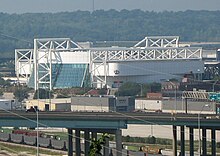Kansas City Scouts
Governor William Morris (former owner of the Central Hockey League's Kansas City Blues), Stan Glazer and Arthur Rhoades headed up the other three potential ownership groups.
[2][5] The club's logo was designed by lettering artist Gary Sartain of Kansas City-based Hallmark Cards in 1973 on a free-lance basis.
Like many other expansion teams, the Scouts performed poorly garnering only 41 points with a record of 15–54–11 in their inaugural season,[2] though this would be the better result of their two-season history.
In their two seasons, the Scouts went through three coaches – Bep Guidolin, Sid Abel (three-game interim stint), and Eddie Bush.
The franchise failed to make the playoffs in either season in Kansas City and won only 27 of 160 games, including a 7–66–7 mark away from home.
[4] Attendance tailed off so much that the National Hockey League Players' Association (NHLPA) wondered if the Scouts would make payroll.
[3] The Scouts suffered from inflated player costs, undercapitalized ownership, an economic downturn in the Midwest, poor performances on the ice and weak attendance.
[2] While the Capitals were far worse on the ice, their owner, Abe Pollin, had the financing and the patience to absorb the typical struggles of a 1970s expansion team.
The Scouts were put up for sale with a Denver-based group led by oilman Jack A. Vickers looking to buy the club.
A local group, according to author Troy Treasure, led by Scouts' limited partners Gene Novorr and George Shore, was also interested but when the NHL informed the Scouts' owners that they would be on the hook of over a million dollars in expansion and territorial fees (owed the St. Louis Blues) if they did not sell to Vickers, they reluctantly did so on July 26, 1976.
The Scouts and the California Golden Seals, who moved to become the Cleveland Barons the same year, were the first NHL teams to relocate since the 1934–35 season.
Following the Scouts departure, Carlson called Major League Baseball games for the Kansas City Royals and Cincinnati Reds.
In 1974–75, Gene Osborn[11][12] was the sole television play-by-play announcer, also on KBMA, with analysis provided by Bill Grigsby.
KBMA was an independent station distributed in the Midwest via cable television, including the cities of Des Moines, Iowa and Wichita, Kansas.

